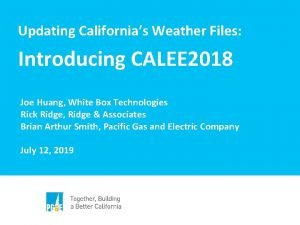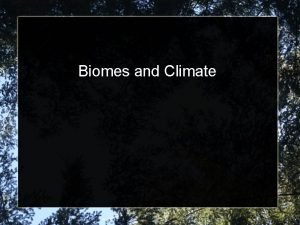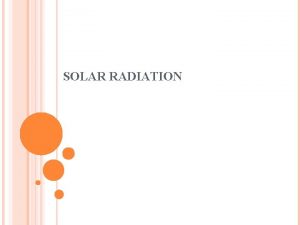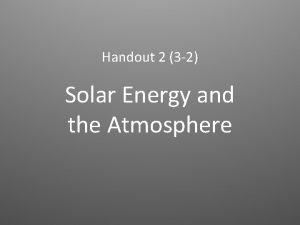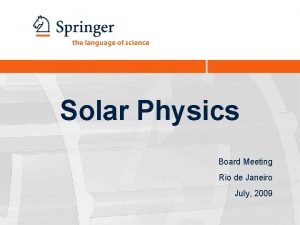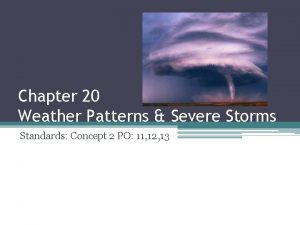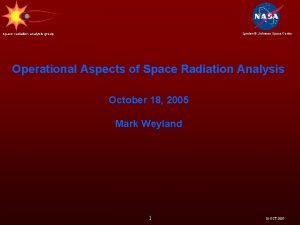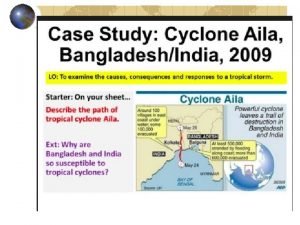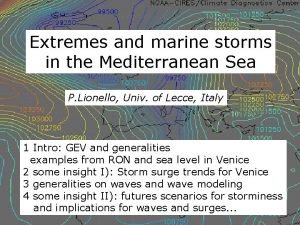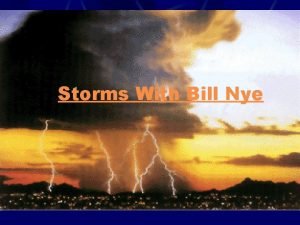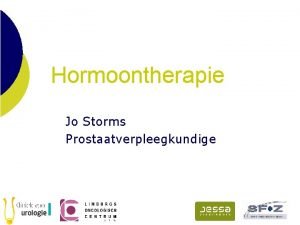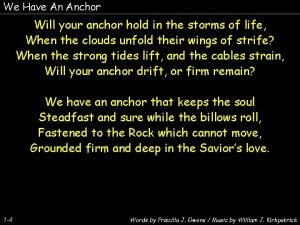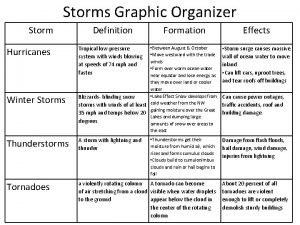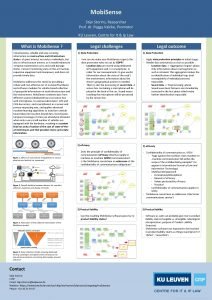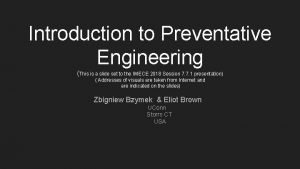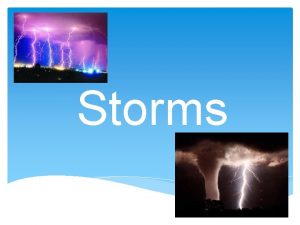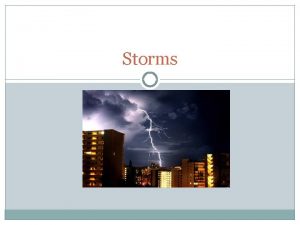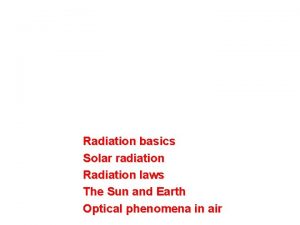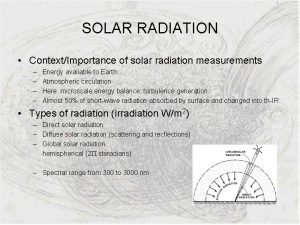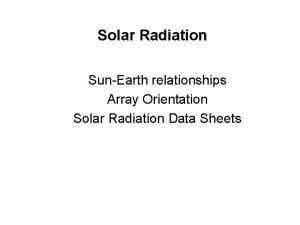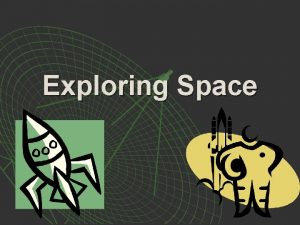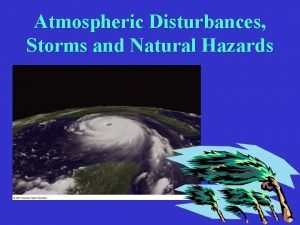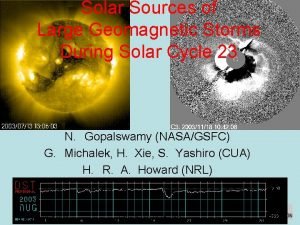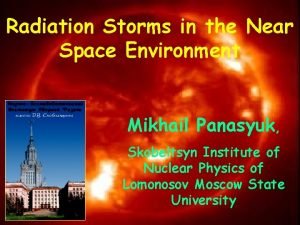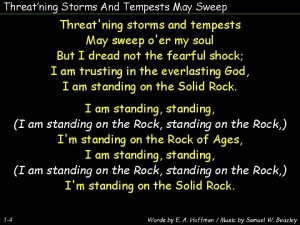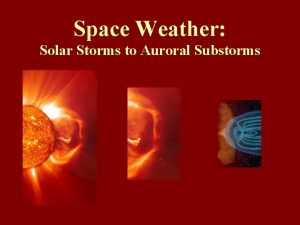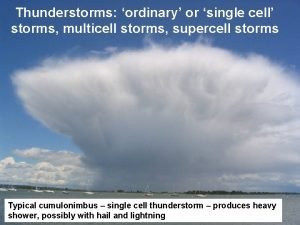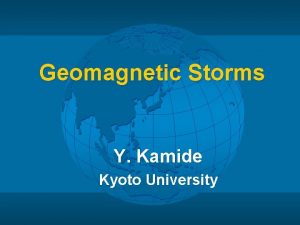Solar Radiation Storms and their Impact on Space





















- Slides: 21

Solar Radiation Storms and their Impact on Space Weather Raúl Gómez-Herrero, Bernd Heber, Robert F. Wimmer-Schweingruber and Reinhold Müller-Mellin Institut für Experimentelle und Angewandte Physik, Christian‐Albrechts‐Universität Kiel, Germany Session 5, Nov 9, 2007 Planetary space weather

Space Weather • What is Space Weather? "Conditions on the Sun and in the solar wind, magnetosphere, ionosphere and thermosphere that can influence the performance and reliability of space-borne and ground-based technological systems and can endanger human life or health. " (U. S. National Space Weather plan) • What is the origin of the Space Weather? The ultimate origin of the space weather is (mainly) the magnetic variability of the Sun: Eruptive phenomena (Solar flares, CMEs) Effects in the interplanetary medium (Energetic particles, Shocks, IMF disturbances) Quiet Sun (High speed streams from Coronal Holes CIRs) • Other sources (not solar, but affected by the Sun): Cosmic rays, interplanetary dust particles, debris, meteoroids, asteroids and comets 1

Consequences of Space Weather (in the Solar Wind) • Outside the magnetosphere, the most relevant Space Weather Effect are the Solar Radiation Storms (elevated levels of radiation that occur when the numbers of energetic particles increase) • Biological effects (ICRP, 1991) –Acute effects (Malfunctions of organs, eye cataracts, etc). Deterministic, threshold doses –Late effects (DNA damage, mutations, cancer) Stochastic, no threshold doses Accumulated dose from GCR is a serious problem for long voyage scenarios (Mars), even at solar maximum • Effects on technology (Valtonen 2005) –Surface charging (charge acc. by interaction with plasma, fields, or e. m. radiation) –Sputtering on surfaces –Contamination (e. g. by sputtering products) –Internal charging (by high energy electrons) –Single event effects (single particle strikes in spacecraft electronics) –Total ionizing damage (accumulated dose) –Displacement damage (displacement of atoms in the lattice) –Radiation induced interference and background 2

Consequences of Space Weather (in the Solar Wind) Jul 14, 2000 Nov 4, 2001 (Brekke et al, 2004) 3

Sources of energetic particles • Corotating Interaction Regions (CIRs) (only < 20 Me. V/n ions) • Solar Energetic particle events (Flare and CME related) • Other populations of non solar origin, but strongly controlled by the large scale structure of the heliospheric magnetic field, and consequently by the solar cycle (modulation). – Galactic Cosmic Rays (GCR) – Anomalous Cosmic Rays (ACR) (only during solar minimum) – Jovian electrons These populations are also affected (locally) by transient phenomena like CMEs or CIRs (e. g. Forbush decreases) IGPP Univ. of California Riverside 4

Sources of energetic particles • During Solar quiet conditions, > 10 Me. V proton flux is less than 1 (cm 2 s sr)-1. In large SEP events it can exceed 104 (cm 2 s sr)-1 severe radiation hazard to humans and onboard equipment • Composition is important because large abundances of heavy elements (Fe) can increase the dose significantly • Spectral contributions are variable but general characterization is possible: Mewaldt et al. , 2001 5

Solar Energetic Particle Events • SEP events are the largest component of the interplanetary >10 Me. V proton fluxes at radial distances 1 AU • Solar Energetic particle events – Impulsive (flare related) – Gradual (CME, shock related) • The separation scheme is not so clear (mixed contributions, hybrid events) • Impulsive events: – Frequently 3 He and heavy elements – But, lower intensity, short duration, focused Less severe 6

Gradual SEP Events • • Associated to fast CMEs driving IP shocks P, He are more than 99% of the particle flux. Composition, charge states similar to the ambient Corona Energy spectra normally follow power laws with an exponential roll-over (Ellison and Ramaty, 1985): I = I 0 E exp (-E/E 0) • The location of the “knee” is important for the dose: – 100 Me. V protons require 10 g cm-2 shielding = 3. 8 cm aluminium – 300 Me. V protons require 66 g cm-2 shielding = 24 cm aluminium • Extreme events (Sept 1989) can produce doses ~4 c. Sv/h behind 10 g cm-2 of shielding annual dose limit for astronauts (25 c. Sv) would be accumulated in 6 -7 h They are the most significant for Space Weather Reames, 1999 Lopate, 2001 7

Maximum Flux - Streaming limited intensities • “Streaming limit”: protons streaming away from a shock, generate Alfvén waves which scatter protons coming behind. (Reames and Ng, 1998) • Exact values depend on transport conditions. Some events do not follow the streaming limit 8

Intensity scaling for SEP events • Characterization of the dependence of fluences and peak fluxes during SEP events with heliolongitude and radial distance are important for future missions • The angular separation between the observer footpoint and the source active region is a key parameter for the time profiles • Intensity dependence: exp (-k( - 0)2), k [1. 0, 1. 3] rad -2 (Lario et al, 2006) • Asymmetric angular distribution shifted to the east ( 0<0) • Radial dependences weaker than R-2 within 1 AU Vainio, 2006 9

SEP Events - Forecasting • The occurrence rate is related to the solar cycle, but short term forecasting is difficult: – Occurrence of CMEs and flares are difficult to predict from precursor signatures (e. g. sigmoids and CMEs) – Prediction of the ICME/shock transit time to 1 AU and the importance of the possible ESP spike is also complicated – However, correlations between SEP intensities and CME properties can be found (e. g. power law dependence between peak flux and projected CME velocity from coronograph images, Reames, 2000) – SEP flux increases very quickly to high levels after the e. m. emissions from the flare/CME (minutes, hours) – New forecasting techniques using relativistic electrons as predictors for ion intensity profile (>20 min anticipation alert) Posner, 2007 10

SEP Events - Forecasting • Long term fluences forecasting for mission planning is based on probabilistic models (e. g. Feynman et al, 1993, Xapsos et al, 1998, Nymmik 2004) • Better understanding of the physical processes governing particle acceleration and propagation during SEP events is essential to improve forecasting quality: – Acceleration and Injection processes near the Sun – Timing: particle onset times vs. flare onset and CME lift-off times – SEP Interplanetary transport (diffusive models) – Interplanetary propagation of disturbances (ICMEs and shocks) 11

Conclusions • Outside the Magnetosphere the most important contribution to Space Weather is the energetic particle radiation • During the last years a numerous spacecraft fleet offered accurate In-situ and remote-sensing measurements of plasma, fields, particles and e. m. emissions. The SEP events of solar cycle 23 were the best observed in history • The most severe Solar Radiation Storms are caused by large streaming-limited Gradual SEP events showing also ESP spikes. They are the main contribution to the total fluence • The ICME-shock geometry organizes the spatial distribution of intensities during the events • Forecasting models and tools become progressively more reliable. However, better knowledge about Physics behind Space Weather is needed (acceleration, propagation). CMEs and flares can not be predicted yet. • More observation points and new technologies are required to attain a wider spatial coverage and better data quality (resolution, time cadence, background, …) • New missions will help to achieve these goals (SDO, Sentinels, Solar Orbiter, IBEX, Solar Probe, Swarm, Geostorm, …) 12

Conclusions • Outside the Magnetosphere the most important contribution to Space Weather is the energetic particle radiation • During the last years a numerous spacecraft fleet offered accurate In-situ and remote-sensing measurements of plasma, fields, particles and e. m. emissions. The SEP events of solar cycle 23 were the best observed in history 'My God, space is radioactive!' • The most severe Solar Radiation Storms are caused by large streaming-limited Gradual SEP events showing also ESP spikes. They are the main contribution to the total fluence Ernie Ray, 1958 • The ICME-shock geometry organizes the spatial distribution of intensities during the events • Forecasting models and tools become progressively more reliable. However, better knowledge about Physics behind Space Weather is needed (acceleration, propagation). CMEs and flares can not be predicted yet. (member of Van Allen's Explorer I team) • More observation points and new technologies are required to attain a wider spatial coverage and better data quality (resolution, time cadence, background, …) • New missions will help to achieve these goals (SDO, Sentinels, Solar Orbiter, IBEX, Solar Probe, Swarm, Geostorm, …) 13

Additional Slides… • ___ 14

Additional Slides… • ___ 15

SEP Events 16

Intensity scaling for SEP events • The dominant parameter is the longitudinal distance between the magnetic footpoint of the spacecraft and the site of the associated solar flare, rather than the heliocentric radial distance of the observer (Lario et al, 2006): – The decrease of peak intensities and fluences with the angular distance between the flare site and the observer’s magnetic footpoint can be approx. by: exp (-k( - 0)2), with k [1. 0, 1. 3] rad -2 – Angular distributions of peak intensities and fluences are not symmetric around the longitude of the observer’s footpoint but shifted toward eastern longitudes – Radial dependences Rn are weaker than those usually recommended (R-2) to extrapolate particle intensities to distances R < 1 AU The use of the previously suggested radial dependences may overestimate the values extrapolated from near-Earth observations to distances R <1 AU 17

Space storms (NOAA Space Weather Scales) Radio blackouts (soft X-ray flux) direct effect of flares on the diurnal side of the ionosphere HF Radio: HF radio communication blackout Navigation: Outages of low-frequency navigation signals Geomagnetic storms (Kp index) large dynamical changes in the geomagnetic field leading, e. g. , to intensified manetospheric electron fluxes Spacecraft operations: extensive surface charging, problems with orientation, uplink/downlink and tracking satellites Power systems: voltage control and protective system problems, grid systems collapses or blackouts. Transformer damage. Other systems: induced pipeline currents, HF radio propagation sporadic, satellite navigation degraded, aurora seen at low latitudes Solar radiation storms (>10 -Me. V proton flux) radiation effects due to solar energetic particle events Biological: unavoidable radiation hazard to astronauts on EVA; passengers and crew in high-flying aircraft at high latitudes exposed to radiation risk Satellite operations: memory device problems, noise on imaging systems; star-tracker problems; solar panel efficiency degraded Ionization effects: blackout of HF radio communications possible (Vainio, SWW 3 2006) 18

NOAA Space Weather Scale for Radiation Storms 19

Multi-spacecraft observations • A numerous fleet of spacecraft offers better observational coverage than ever before: ACE, Cluster, Fast, Geotail, Hinode, Polar, RHESSI, SOHO, STEREO, THEMIS, TIMED, TRACE, Ulysses, Voyager, Wind (Up to recently also: SAMPEX, IMP-8, Yohkoh, …) • In-situ and remote-sensing instruments onboard these spacecraft offer accurate measurements of plasma, fields, particles and e. m. emissions. The SEP events of solar cycle 23 were the best observed in history • But more observation points are required to attain a wider spatial coverage (in radial distance, heliolongitude and heliolatitude). • New technologies will improve also the data quality (resolution, time cadence, background, …), allowing better knowledge of the physics behind SEP events in different temporal and spatial scales. • These goals will be achieved by new missions during the upcoming years: SDO, Sentinels, Solar Orbiter, IBEX, Solar Probe, Swarm, Bepi. Colombo, Geostorm, … 20
 Solar radiation has a part in the water cycle by
Solar radiation has a part in the water cycle by National solar radiation database
National solar radiation database Average weather conditions over time
Average weather conditions over time Solar radiation
Solar radiation Solar radiation
Solar radiation Solar physics impact factor
Solar physics impact factor Chapter 20 weather patterns and severe storms
Chapter 20 weather patterns and severe storms Chapter 20 weather patterns and severe storms
Chapter 20 weather patterns and severe storms Wholesale solar battery solutions
Wholesale solar battery solutions An inexhaustible source of energy
An inexhaustible source of energy Space radiation
Space radiation What is the global distribution of tropical storms
What is the global distribution of tropical storms Amun ra god
Amun ra god Storms in the mediterranean sea
Storms in the mediterranean sea Egyptian god of storms
Egyptian god of storms Bill nye tornadoes
Bill nye tornadoes Jo storms
Jo storms Will your anchor hold
Will your anchor hold Winter storms definition
Winter storms definition Stijn storms
Stijn storms Freddy storm
Freddy storm Hurricanes tropical storms
Hurricanes tropical storms

